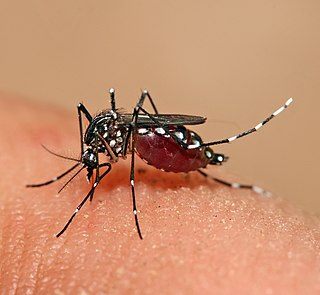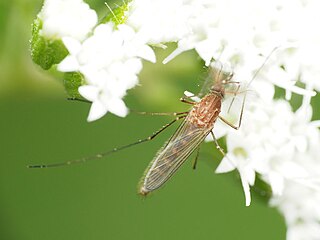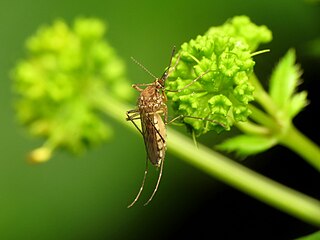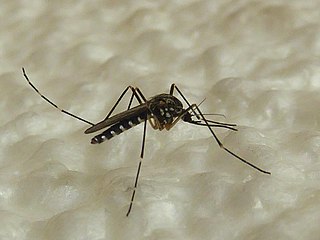
Mosquitoes, the Culicidae, are a family of small flies consisting of 3,600 species. The word mosquito is Spanish and Portuguese for little fly. Mosquitoes have a slender segmented body, one pair of wings, three pairs of long hair-like legs, and specialized, highly elongated, piercing-sucking mouthparts. All mosquitoes drink nectar from flowers; females of some species have in addition adapted to drink blood. The group diversified during the Cretaceous period. Evolutionary biologists view mosquitoes as micropredators, small animals that parasitise larger ones by drinking their blood without immediately killing them. Medical parasitologists view mosquitoes instead as vectors of disease, carrying protozoan parasites or bacterial or viral pathogens from one host to another.

Aedes albopictus, from the mosquito (Culicidae) family, also known as the (Asian) tiger mosquito or forest mosquito, is a mosquito native to the tropical and subtropical areas of Southeast Asia. In the past few centuries, however, this species has spread to many countries through the transport of goods and international travel. It is characterized by the white bands on its legs and body.

Aedes is a genus of mosquitoes originally found in tropical and subtropical zones, but now found on all continents except Antarctica. Some species have been spread by human activity: Aedes albopictus, a particularly invasive species, was spread to the Americas, including the United States, in the 1980s, by the used-tire trade.

Arbovirus is an informal name for any virus that is transmitted by arthropod vectors. The term arbovirus is a portmanteau word. Tibovirus is sometimes used to more specifically describe viruses transmitted by ticks, a superorder within the arthropods. Arboviruses can affect both animals and plants. In humans, symptoms of arbovirus infection generally occur 3–15 days after exposure to the virus and last three or four days. The most common clinical features of infection are fever, headache, and malaise, but encephalitis and viral hemorrhagic fever may also occur.
La Crosse encephalitis is an encephalitis caused by an arbovirus which has a mosquito vector.

Aedes aegypti, the yellow fever mosquito, is a mosquito that can spread dengue fever, chikungunya, Zika fever, Mayaro and yellow fever viruses, and other disease agents. The mosquito can be recognized by black and white markings on its legs and a marking in the form of a lyre on the upper surface of its thorax. This mosquito originated in Africa, but is now found in tropical, subtropical and temperate regions throughout the world.

Culex restuans is a species of mosquito known to occur in Canada, the United States, Mexico, Guatemala, Honduras, and the Bahamas. It is a disease vector for St. Louis encephalitis and West Nile virus. In 2013 West Nile Virus positive specimens were collected in Southern California.

Aedes vexans, the inland floodwater mosquito or tomguito, is a cosmopolitan and common pest mosquito.

Mosquito-borne diseases or mosquito-borne illnesses are diseases caused by bacteria, viruses or parasites transmitted by mosquitoes. Nearly 700 million people contract mosquito-borne illnesses each year, resulting in more than a million deaths.

Aedes triseriatus is a member of the true fly order. It is called the eastern treehole mosquito due to its predilection towards breeding in stagnant water that is found in natural holding containers such as tree holes. It is native to the eastern United States and southern Canada and favors hardwood habitats. It has been found as far south as the Florida Keys, as far west as Idaho and Utah, and as far north as Quebec and Ontario. This species has not yet been found in Europe, but it has the potential to spread through international trade. In 2004, it was found in a shipment of tires travelling from Louisiana to France, but it was identified and targeted with insecticides that truncated its spread. It is a known vector of La Crosse encephalitis and canine heartworm disease. In the laboratory, it has been found to vector several other viruses including yellow fever, eastern encephalitis, Venezuelan encephalitis, and western encephalitis. Because of its potential for international spread and its proclivity for transmitting disease, monitoring the distribution of this species is essential.

Culex quinquefasciatus, commonly known as the southern house mosquito, is a medium-sized mosquito found in tropical and subtropical regions of the world. It is a vector of Wuchereria bancrofti, avian malaria, and arboviruses including St. Louis encephalitis virus, Western equine encephalitis virus, Zika virus and West Nile virus. It is taxonomically regarded as a member of the Culex pipiens species complex. Its genome was sequenced in 2010, and was shown to have 18,883 protein-coding genes.
Aedes africanus is a species of mosquito that is found on the continent of Africa with the exclusion of Madagascar. Aedes aegypti and Aedes africanus are the two main yellow fever vector species in Zambia. Aedes africanus is mainly found in tropical forests not near wetlands.

Aedes koreicus, the Korean bush mosquito is a species of mosquito in the genus Aedes. The adults are relatively large with a black and white pattern on their legs and other body parts. Clear longitudinal lines on the dorsal part of the thorax distinguish it from Ae. aegypti and Ae. albopictus. The species bears close morphological, ecological, and genetic similarity to the Asian bush mosquito, Aedes japonicus, but can be physically distinguished by a pale basal band on the hind tarsomere.

Aedes japonicus, commonly known as the Asian bush mosquito or the Asian rock pool mosquito, was first described by Theobald in 1901 from Tokyo, Japan. They are competent arbovirus vectors known to transmit the West Nile virus as well as Japanese and St. Louis encephalitis. They are listed as an invasive species by the Global Invasive Species Database.

Culex nigripalpus is a species of medium-sized, dark, blood-feeding mosquito of the family Culicidae.

Culiseta melanura, the black-tailed mosquito, is a species of mosquito in the family Culicidae. It is found mainly in the eastern and central United States.

Aedes taeniorhynchus, or the black salt marsh mosquito, is a mosquito in the family Culicidae. It is a carrier for encephalitic viruses including Venezuelan equine encephalitis and can transmit Dirofilaria immitis. It resides in the Americas and is known to bite mammals, reptiles, and birds. Like other mosquitoes, Ae. taeniorhynchus adults survive on a combination diet of blood and sugar, with females generally requiring a blood meal before laying eggs.

Aedes epactius is a species of mosquito (Culicidae) native to North America.

Aedes scapularis is a species of mosquito primarily found in neo-tropical regions of the Americas.
Culex thriambus is a mosquito species that appears in the southwestern United States, including Southern California, Texas, as well as in Mexico. It is a confirmed vector of West Nile virus. The majority of host species the mosquito takes blood from are in the order Passeriformes.















